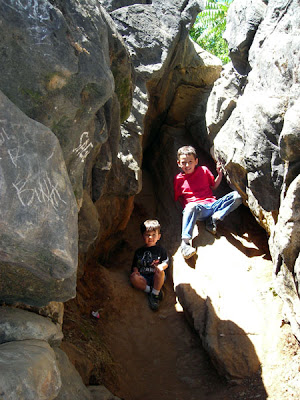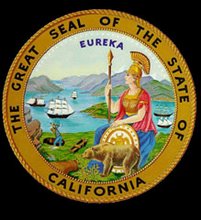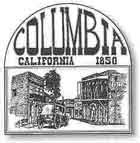 Because Columbia is situated about a mile off of State Route 49, I missed it the first time I drove through. So this time, I thought we would at least stop by and see whats there. Turns out, Columbia is quite the gem! We ended up having a blast and spent the whole day there.
Because Columbia is situated about a mile off of State Route 49, I missed it the first time I drove through. So this time, I thought we would at least stop by and see whats there. Turns out, Columbia is quite the gem! We ended up having a blast and spent the whole day there. 
Columbia is situated in the heart of the richest gold mining area of the Mother Lode. The Mother Lode is a region of gold bearing quartz, about one to four miles wide and 120 miles long, which stretches from Georgetown in El Dorado County on the north, through Amador, Calaveras, and Tuolomne counties, south to Mormon Bar in Mariposa county.

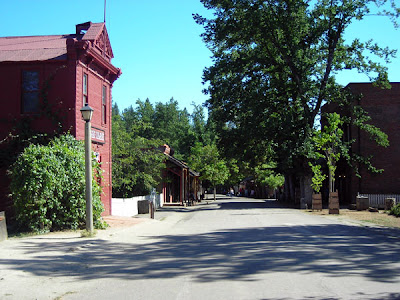
A beautiful town, Columbia is unique in many ways to the other mining towns of the Mother Lode. Closed to vehicular traffic, it's tree lined Main Street make for a very tranquil setting. As we explored the shops and exhibits, I could let the kids run around and not worry about them getting hit by cars.
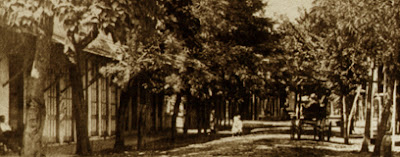 The omnipresent trees seem to have been there throughout the history of the town. They offer a welcome relief from the sun on hot days.
The omnipresent trees seem to have been there throughout the history of the town. They offer a welcome relief from the sun on hot days.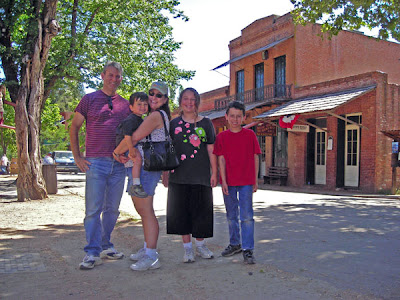

A lively town, Columbia has a variety of shops and activities offering everything from souvenirs, books, handmade candy, chocolates, coffee and other fine confectionery treats, fine dining, family dining, snacks, live theater, old time photos, 1850s era saloons, quilting supplies, museums, period exhibits and displays, costumes, gold panning, stagecoach rides, a gold mine tour, to name some of the fun.
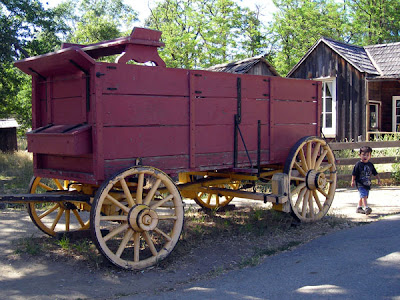 Parkie is impressed, this red wagon is much bigger that his little red wagon at home!
Parkie is impressed, this red wagon is much bigger that his little red wagon at home! Costumed musicians seem to be on every corner, providing period music that became the soundtrack of our day.
Costumed musicians seem to be on every corner, providing period music that became the soundtrack of our day.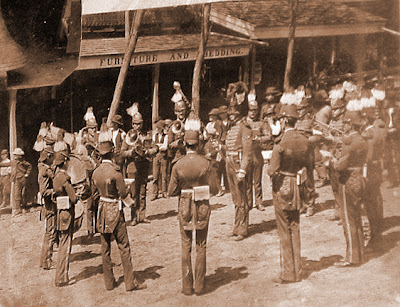
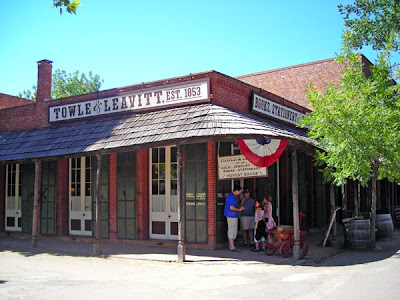 One thing all the mining towns have in common; they've all burned at one time or another. Often more than once. If the town prospered, they rebuilt. If not, the town disappeared into history. Columbia, which burnt at least twice, was very prosperous, so many of the buildings were rebuilt with “fireproof” materials. The red brick and green iron shutters are prevalent with almost all the buildings here.
One thing all the mining towns have in common; they've all burned at one time or another. Often more than once. If the town prospered, they rebuilt. If not, the town disappeared into history. Columbia, which burnt at least twice, was very prosperous, so many of the buildings were rebuilt with “fireproof” materials. The red brick and green iron shutters are prevalent with almost all the buildings here.
The mining in Columbia was “dry diggings”. Having no natural streams, only seasonal gulches, water had to be piped in from some 60 miles away and so was not plentiful. Mining was done by building a long sluice and then digging away at the surrounding gold bearing soil and running it through theses sluices.

As a result, at the south end of town the terrain drops about 10 feet because of all the soil being mined away, leaving these formations of rock. These formations create acres of labyrinthine passageways, mazes, caves and tunnels.
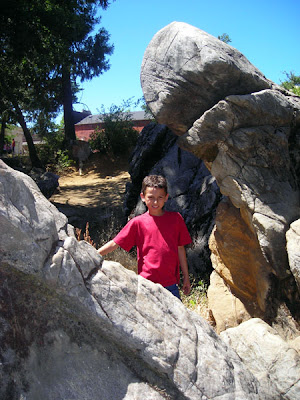
These rocks were underground until mining excavated the soil away from around them.
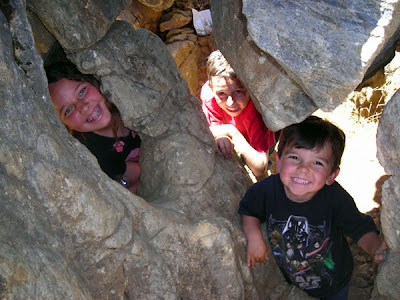
 Some of the things to discover in this maze are a gold mine and this miners shack.
Some of the things to discover in this maze are a gold mine and this miners shack.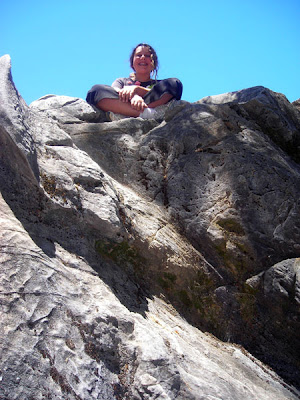 This leftover rock turned out to be excellent building material for the town. Today a marble quarry is worked nearby.
This leftover rock turned out to be excellent building material for the town. Today a marble quarry is worked nearby.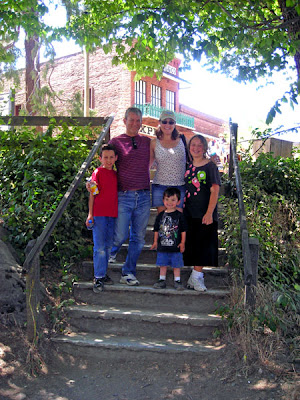 These stairs from the town down into the “diggin's” is built with marble from the diggin's.
These stairs from the town down into the “diggin's” is built with marble from the diggin's.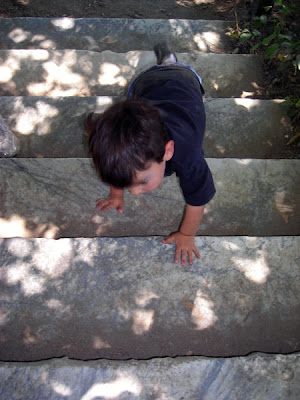 Parkie takes a closer look at the marble stairs.
Parkie takes a closer look at the marble stairs.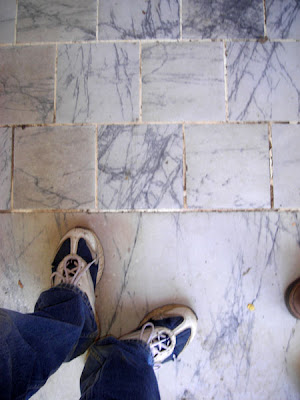 The tile floor of the ice cream parlor is made from marble from the diggin's.
The tile floor of the ice cream parlor is made from marble from the diggin's.
Hey wait a minute! Did somebody say “ice cream parlor”?
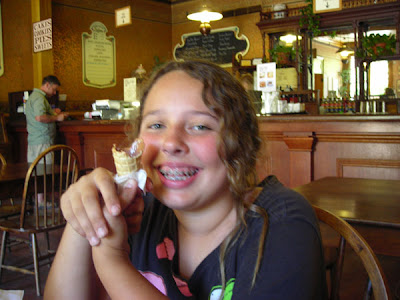 Ice cream sounds good right about now. I think Rachelle would agree. Like all the buildings in Columbia, the Fallon building has an old timey interior.
Ice cream sounds good right about now. I think Rachelle would agree. Like all the buildings in Columbia, the Fallon building has an old timey interior.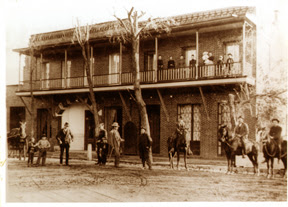 The Fallon building in the 1890s.
The Fallon building in the 1890s.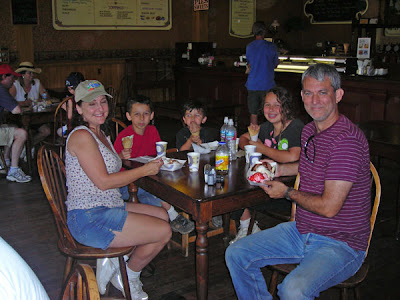 After a hot day exploring the town and the diggin's, nothing cools and replenishes the spirit like ice cream cones, sundaes and splits.
After a hot day exploring the town and the diggin's, nothing cools and replenishes the spirit like ice cream cones, sundaes and splits. On the next installment of A California Adventure;
On the next installment of A California Adventure; Water up the horses, were going for a ride on the mudwagon!
For more information about Columbia State Historic Park, visit their website:
For more information about Columbia State Historic Park, visit their website:
